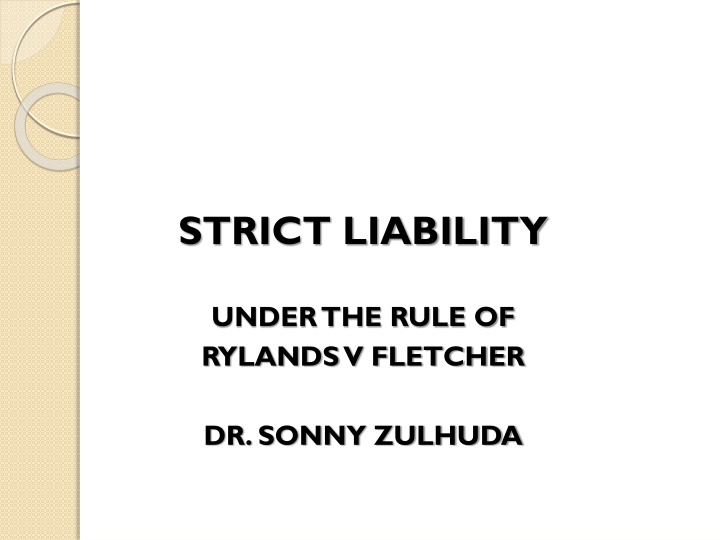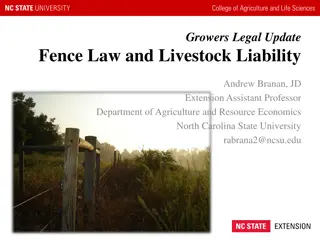Strict Liability under the Rule of Rylands v. Fletcher
Strict liability under the rule of Rylands v. Fletcher establishes that a person who brings something onto their land that is likely to cause harm if it escapes is responsible for any resulting damage, regardless of negligence. The case of Rylands v. Fletcher (1868) set the precedent for this doctrine, holding the defendant liable for the escape of water from a reservoir that caused harm to the plaintiff's mines. The elements required to prove liability include the non-natural use of land by the defendant, the escape of the damaging thing, and the foreseeability of harm.
Download Presentation

Please find below an Image/Link to download the presentation.
The content on the website is provided AS IS for your information and personal use only. It may not be sold, licensed, or shared on other websites without obtaining consent from the author.If you encounter any issues during the download, it is possible that the publisher has removed the file from their server.
You are allowed to download the files provided on this website for personal or commercial use, subject to the condition that they are used lawfully. All files are the property of their respective owners.
The content on the website is provided AS IS for your information and personal use only. It may not be sold, licensed, or shared on other websites without obtaining consent from the author.
E N D
Presentation Transcript
STRICT LIABILITY UNDER THE RULE OF RYLANDS V FLETCHER DR. SONNY ZULHUDA
Outline Definition Elements Non-natural use of land Escape Reasonable foreseeability Defences & Recent Position
Rylands v Fletcher [1868] UKHL 1 John Rylands (D) constructed a reservoir on his rented land to supply water to his steam-powered textile mill. Thomas Fletcher (C) operated mines on nearby land and had tunnelled up to old disused mines which were under the land where Rylands' reservoir was located. D s contractors did not properly block the shaft beneath, and when filling the reservoir, the water escaped down the shaft and flooded C s mines.
Rylands v Fletcher [1868] UKHL 1 Court held D was liable even though he was not negligent. The English Court of Exchequer: We think that the true law is that the person who, for his own purposes, brings on his land, and collects and keeps there anything likely to do mischief if it escapes, must keep it in at his peril. If he does not do so, (he) is prima facie answerable for all the damage which is the natural consequence of its escape. Other examples where P can sue D for compensation: P whose grass or corn is eaten by D s escaping cattle; P whose mine is flooded by the water from his neighbour s reservoir; P whose habitation is made unhealthy by the fumes and vapours of his neighbour s alkali works
Rylands v Fletcher [1868] UKHL 1 The Rationale (The victim in those incidents) is damnified without any fault of his own; and it seems but reasonable and just that the neighbour, who has brought something on his own property which was not naturally there, harmless to others so long as it is confined to his own property, but which he knows to be mischievous if it gets on his neighbour s, should be obliged to make good the damage which ensues if he does not succeed in confining it to his own property.
Elements of the Rule Elements necessary to prove: 1. The non-natural use of land by D 2. Escape of the thing that causes damage of P s land 3. The foreseeability of damage by D
the said bund was put to uses unsuitable and hazardous to their neighbor (ie) when it was made to hold water in great quantities instead of slimes Here the D have brought for the purposes of their business, dangerous materials (petrol & rubber) which would not naturally be upon the premises, and they are under an obligation.. So as not to cause mischief. Pacific Tin Consolidated Corp v Hoon What amounts to the non-natural use of land? Ang Hock Hai v Tan Sum Lee Non-natural use must be some special use bringing with it increased dangers to others, and must not merely be the ordinary use of the land or such use as is proper for the general benefit of the community Rickards v Lothian
Pacific Tin Consolidated Corp v Hoon Wee Thim [1967] 2 MLJ 35 App maintained on their lands large ponds for tin dredge-mining operations. They separated each ponds with bunds (embankment street). The ponds were above ground level. Water flow from one pond to another by means of spillways. The land was located in an inclined valley. A large breach in the bund between two large ponds, which together held nearly 500mil gallons of water, caused a violent outflow to the lower lands. This caused extensive damage to life and property to the adjacent lands.
Pacific Tin Consolidated Corp v Hoon Wee Thim [1967] 2 MLJ 35 Federal Court applied the rule in Rylands v Fletcher and held Appellant liable. It was found unusual for tin mines in Malaya to have pools above ground level for retaining water. The normal practice is to have mines holes below ground level to retail slimes or tin tailings. Natural user of their property does not imply that miners had carte blanche to carry on their mining operations in any manner they think fit, however hazardous to their neighbours Consequently I hold that the use to which the sand bund was put in this case was a non-natural user of land. (Ong Hock Thye) The bund was put to a non-natural use when it was made to hold water in great quantities instead of slimes (Barakbah LP)
Dato Dr Harnam Singh v Renal Link (KL) Sdn Bhd Ang Hock Hai v Tan Sum Lee D carried on the business of tyre repairers and tyre dealers. For that purpose he kept petrol on the premises, to be mixed with rubber and gum. P lived on the upper floor of the D s premises. D who ran a hemodialysis centre was liable under the rule for the escape of gases into P s premises from the use of formalin and renalin in the operation of the centre. Fire broke out at the premise for unknown cause. It caused three explosions followed by a burst of flame that quickly destroyed the premises. P s wife and son died. It produced noxious gas that escaped into P s clinic one floor below that of the D. P suffered discomfort, sickness and injury
Escape of the thing: In Read v J. Lyons & Co. Ltd. [1947] App (worked in the R s ammunition factory) suffered injury when a shell that was being manufactured exploded. Claim under the rule of Rylands v Fletcher was not successful because there had been no escape of the thing that inflicted the injury. To succeed, there must be an escape from the place where the D has occupation or control, to a place outside his occupation/control Also: Won Tan Kan v Asian Rare Earth Sdn Bhd [1992]
The foreseeability of damage Cambridge Water Co v Eastern Counties Leather plc (1994) C extracts water to supply to the public. It then discovered that the water was contaminated with a solvent (a liquid substance). It emerged that the solvent came from the Eastern Counties Leather plc tannery, about 1.3 miles from the borehole. C claimed on negligence, nuisance and under rule in Rylands v Fletcher. As the D could not have foreseen the damage suffered by C, the claims were nor successful.
Available Defences 1. Consent of the plaintiff 2. Default of the plaintiff 3. Act of God 4. Act of a stranger 5. Statutory authority 6. Common benefit
Benefit for/ Consent of Plaintiff Peters v Prince of Wales Theatre [1943] KB 73 Act of Stranger (where D has no control) Perry v Kendricks Transport Limited [1956] 1 ALL ER 154 Act of God Nichols v Marsland (1876) 2 Ex D 1 Statutory Authority If the escape is a direct result of carrying out the duty Green v Chelsea Waterworks Co (1894)
Dunne v North Western Gas Board [1964] 2 QB 86 Gas escaped from a gas main caused by a burst water main. The gas travelled along a sewer and was ignited causing a series of explosions resulting in injuries to five claimants. One was blown off her bicycle, two young children were injured playing in the street and a husband and wife suffered injuries in their home. They each brought an action based on liability under Rylands v Fletcher. Held: The defendant was not liable. The Gas Board had not accumulated gas for their own purposes.
The Modern Position of the Rule The Rule is between Negligence and Private Nuisance! The applicability of defences: Act of God The requirements of Foreseeability Dunne v North Western Gas Board [1964] 2 QB 86 English Appeal Court asserted that the D s liability in Rylands v Fletcher itself could simply have been placed on the D s failure to take reasonable care. This means that the court had considered reduced usefulness of the Rule!
Malaysian Cases Fanuc SDN BHD v Adenland (Cheras) SDN BHD & Anor [2019] MLJU 537 Abdul Aziz bin Awang @ Muhammad and 99 Others v Tenaga Nasional Bhd [2018] MLJU 908 Tenaga Nasional Bhd v Syarikat Bekalan Air Selangor Sdn Bhd & Anor [2018] 1 MLJ 810























